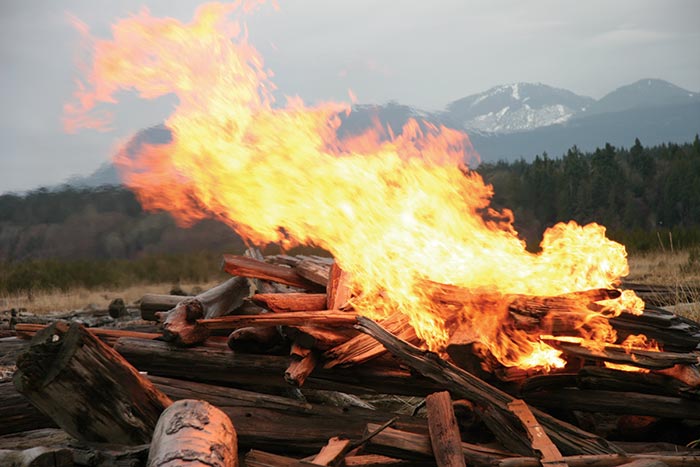
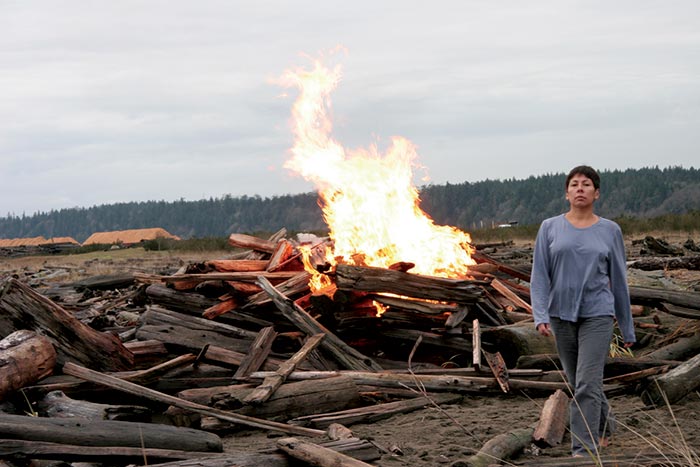
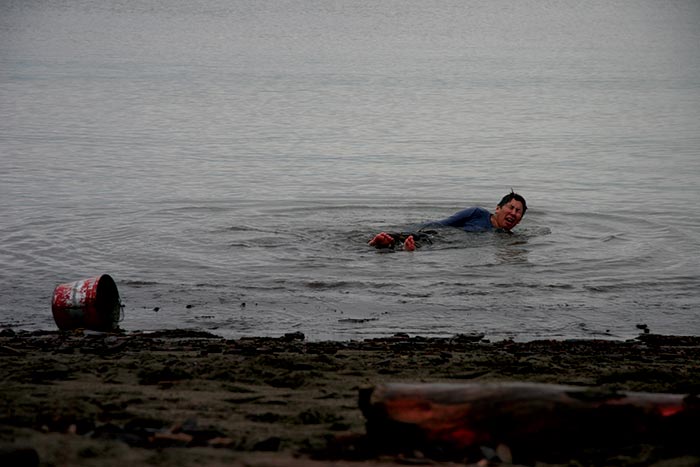
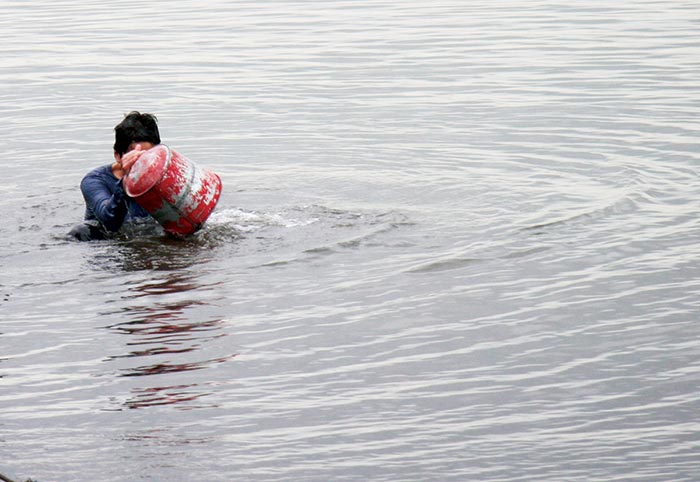
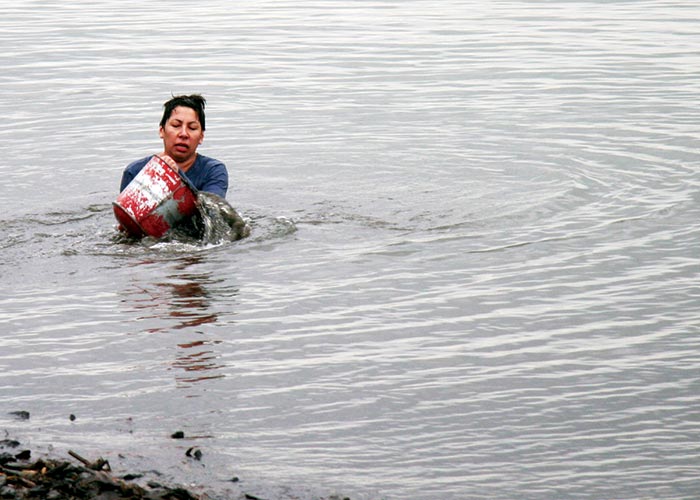
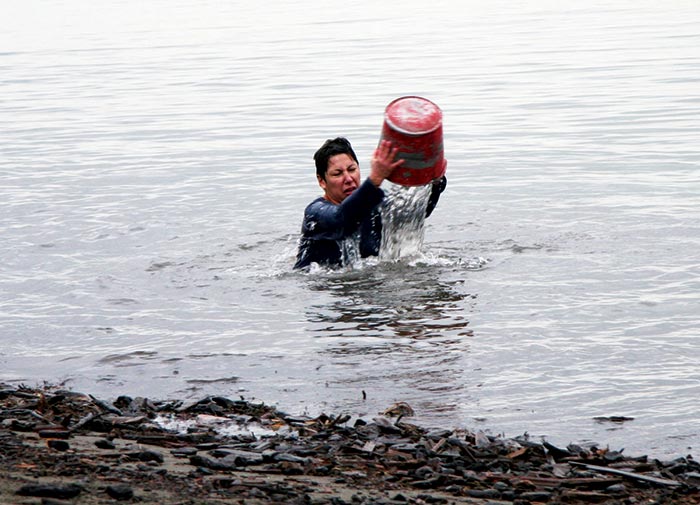
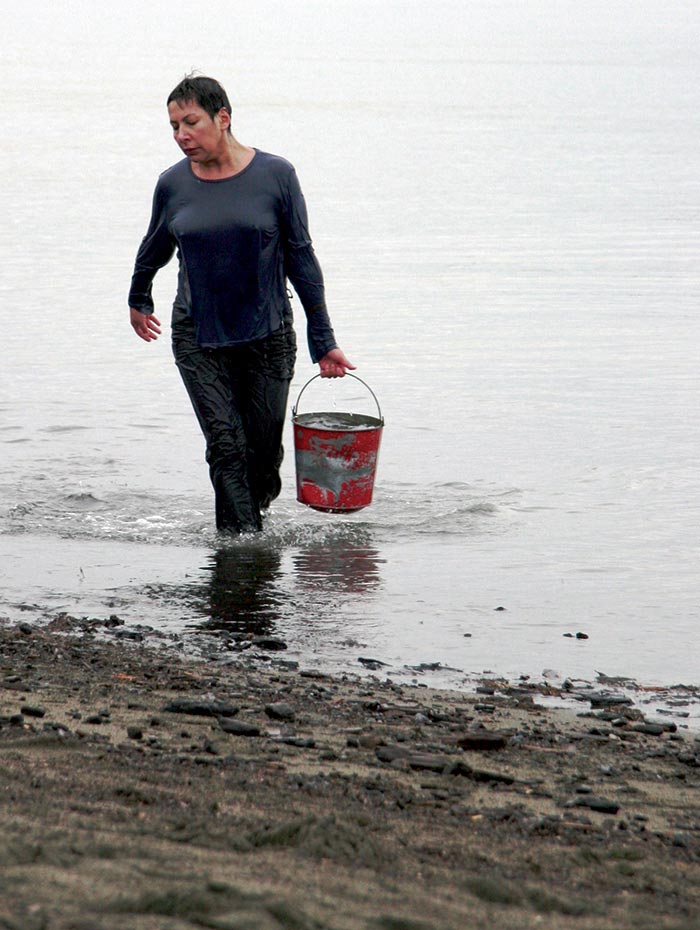
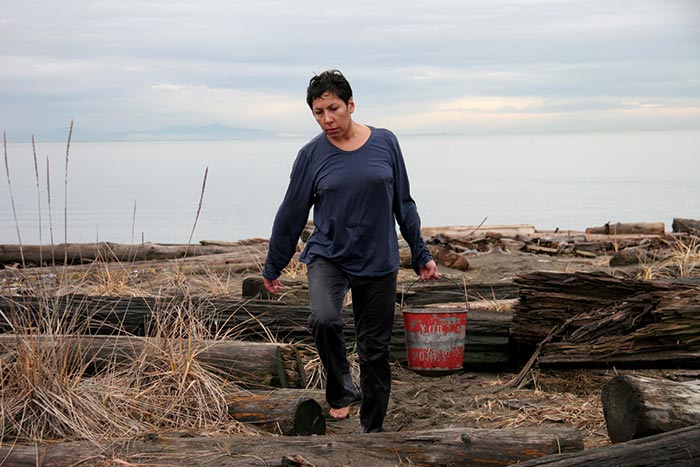
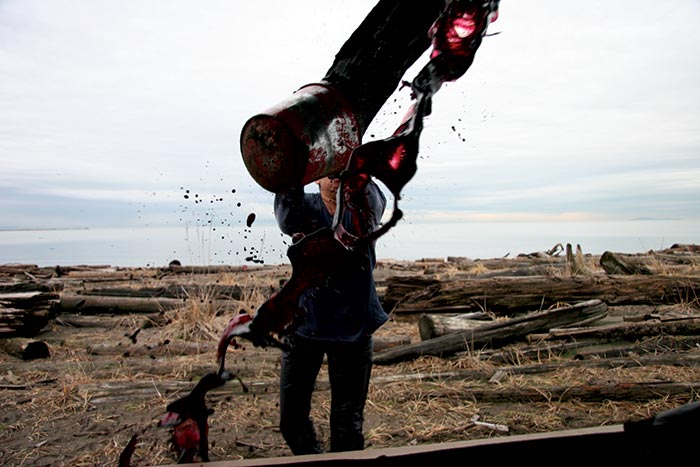
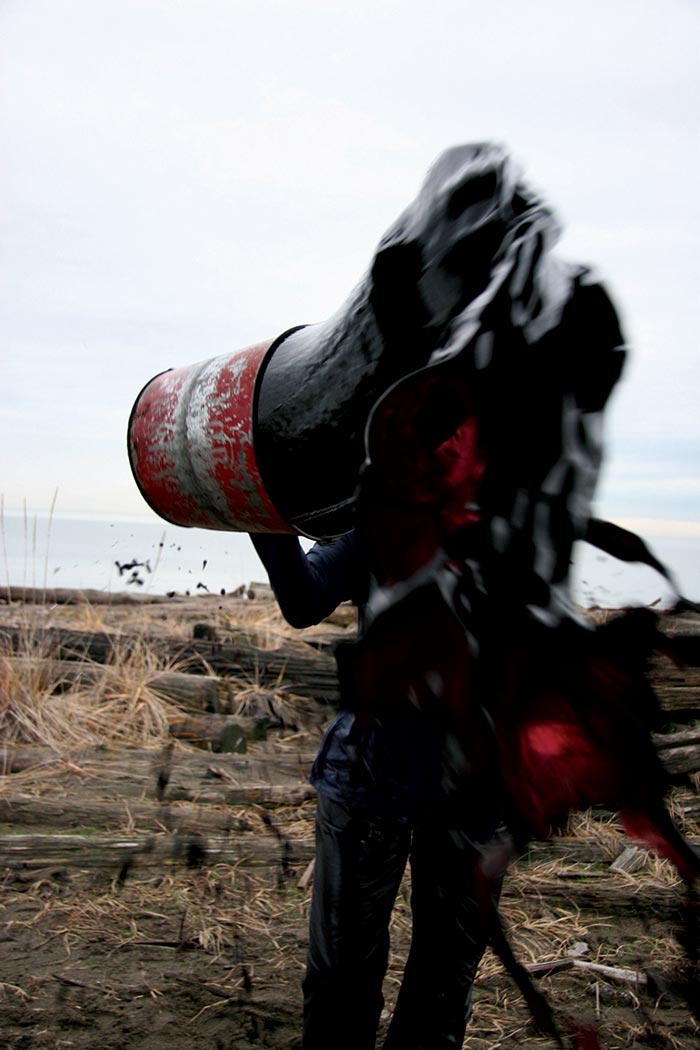
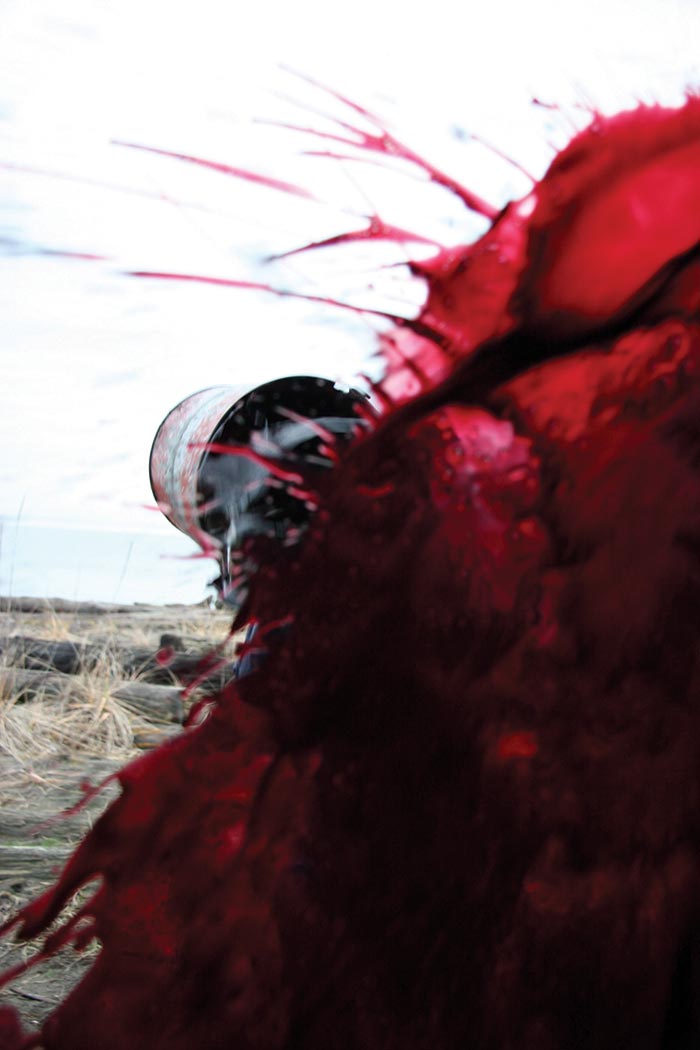
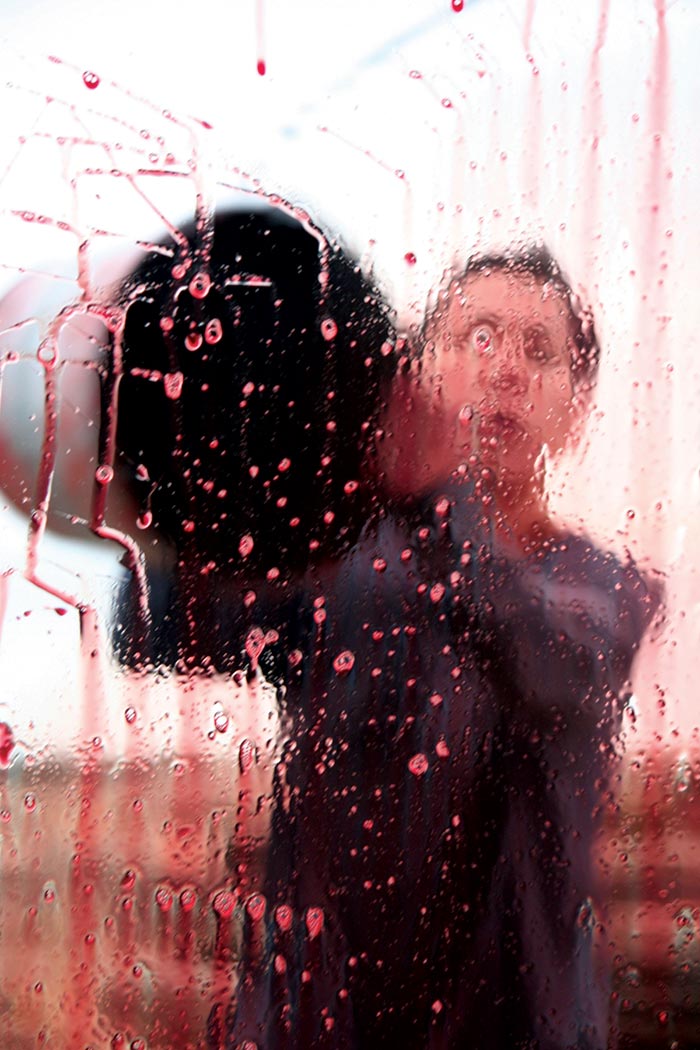
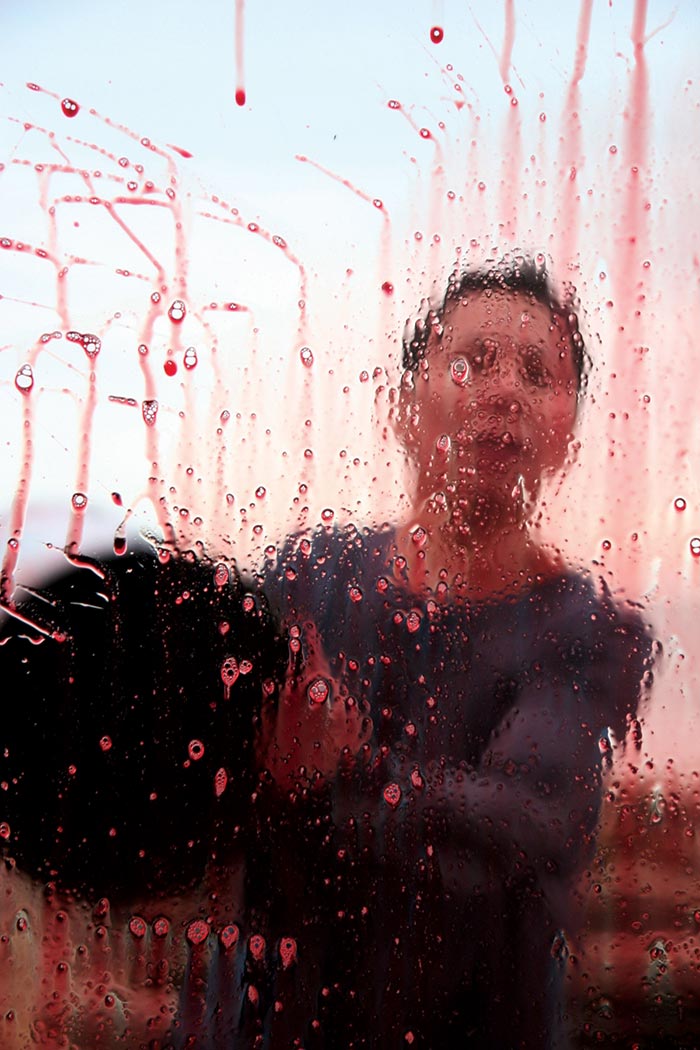
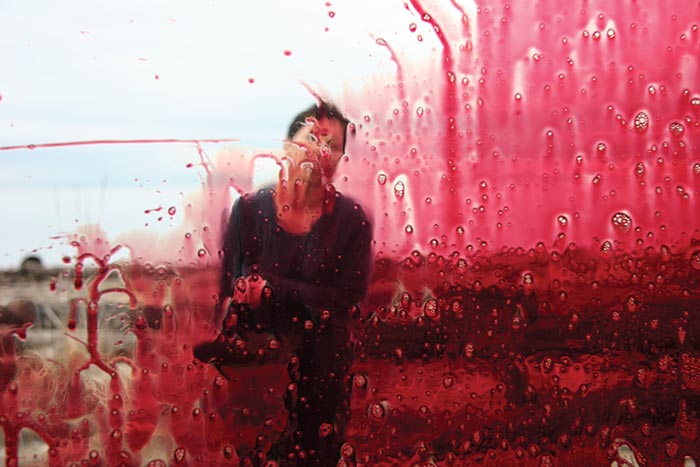
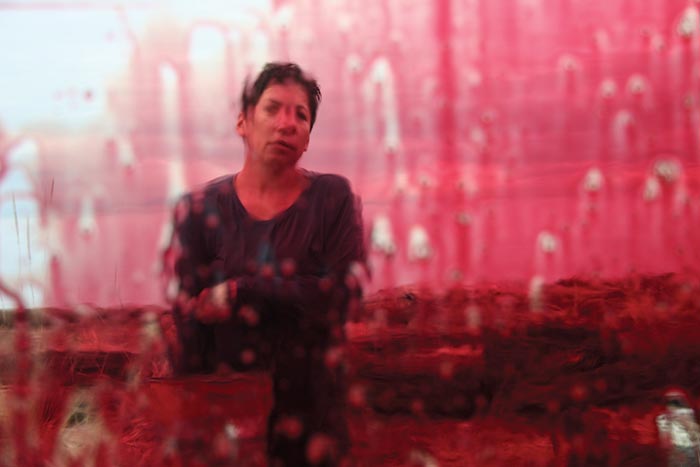
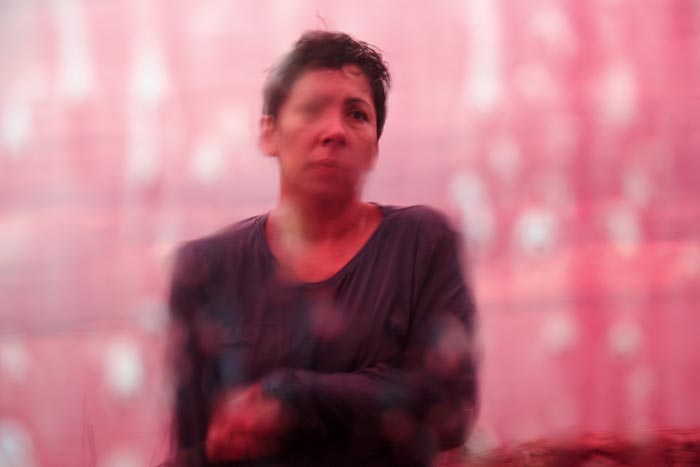
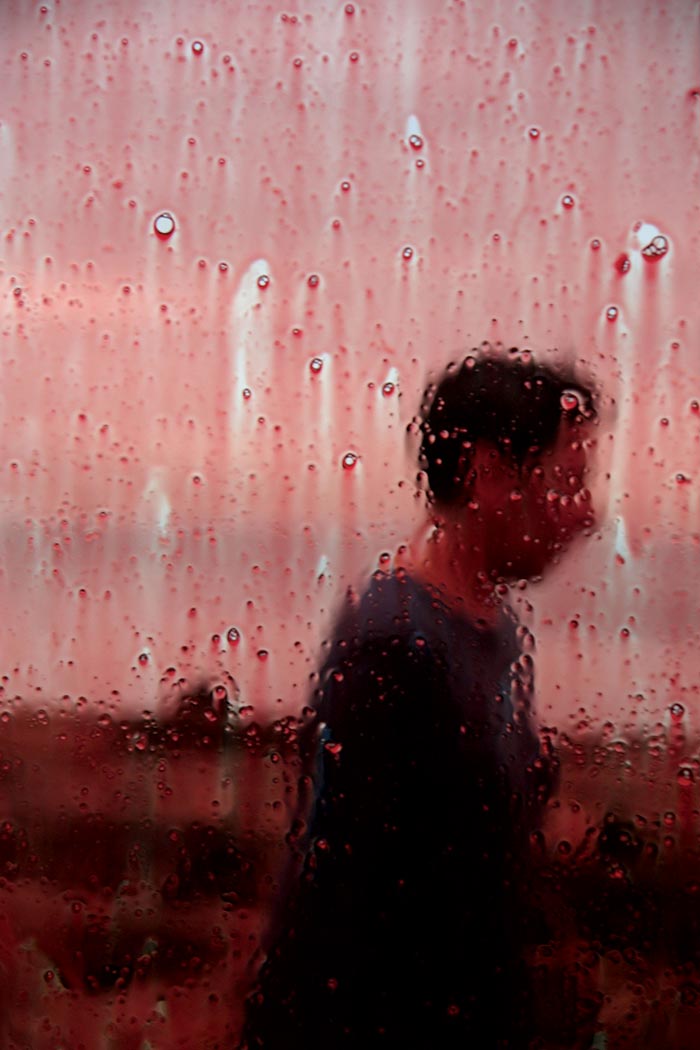
Walking through the small, fussy rooms of The Grange, the 1820s-era residence that was the original home of the Art Gallery of Ontario, during the 2001 exhibition House Guests: Contemporary Artists in The Grange, I came across an ornate little master bedroom in which a beautiful native woman luxuriated in a decadent, mid-afternoon sleep. Shoulders bare, dishevelled jet-black hair spread across a stack of white pillows, she was beneath a crimson duvet that swarmed with great masses of black hair; beaver pelts were nailed to the canopy posts like heraldic shields. The bedroom of a house that still had the claustrophobic prissiness of early-nineteenth-century colonials was the last place I would expect to find an Anishinabe woman from Sioux Lookout in northern Ontario. At first glance, Vancouver-based artist Rebecca Belmore’s performance for House Guests, entitled Wild, was imbued with a shameless, irreverent sensuality, but it did not take long before I became queasy: the masses of black hair seemed to roil and slither over the crimson fabric, and the fabric itself began to look like a glistening river of blood cascading over her body. And when Belmore was not there in the bed, her absence was palpable and haunting—a deep impression on billowing white feather pillows amidst a scene of fresh and strange atrocity.
“Ah,” Belmore yawned, stretching her arms up over her head, when I ran into her one evening outside The Grange. “I had such a good sleep.”
Representing Canada at the 2005 Venice Biennale (June 12 to November 6), Belmore’s art is by turns sumptuously beautiful, emotionally volatile, and elegiac. Her work is rooted in the tragic history of native peoples and cultures in North America, and it can be both startlingly direct and slyly allusive, its sense of humour brutal. At the packed opening of her exhibition at the Art Gallery of Ontario in the summer of 2003, The Named And The Unnamed, Belmore could be found in jeans and tank top, slathering clumps of long-stemmed roses to the gallery wall with dollops of wet plaster she scooped with her hands from a bucket. Two cellists played Joni Mitchell’s Woodstock. The well-dressed, largely white elites of the Toronto art world—museum directors, curators, gallerists, writers, artists—were mesmerized by the performance, by the loveliness of the liquid white plaster, by the comforting nostalgia of Joni Mitchell’s music, by Belmore’s slow, trance-like presence. Yet there was a belligerence and aggression—an unassimilated wildness—that smouldered just beneath the surface of the piece, which commemorated the more than sixty women, many aboriginal, who were abducted and murdered on Vancouver’s East Side. White, in Belmore’s iconography, is the blanketing white of snow, the white of frozen native bodies at Wounded Knee in 1890 or on the outskirts of Saskatoon in 2000, the white skin of European settlers, the white of forced assimilation, the terrifying white of history being erased.
What most of the audience at the Toronto premiere of The Named And The Unnamed did not yet know was that, on the other side of the wall Belmore was covering with roses, there was a video installation based on a performance in 2002 whose tone was unequivocally angry. In Vigil, Belmore appeared at the corner of Gore and Cordova streets in East Vancouver, her bare arms covered with the names of missing women. She goes down hard on her hands and knees and scours the concrete with soapy water; she struggles to light votive candles in a steady breeze. Picking up bunches of roses arranged on the ground, she shouts out the names written on her arms—Sarah! Helen! Andrea! Paula!—then drags the thorny stemmed flowers through her mouth, spitting out the petals. In the next part of Vigil, Belmore dons a bright red dress, nails its broad skirts to a telephone pole, and lunges and thrashes until she tears herself free. She does this again and again with a compulsive determination until the long dress is reduced to tattered shreds. Afterward, she leans against a pickup truck parked on the street. James Brown’s shrill, hysterical voice howls It’s A Man’s Man’s Man’s World from the truck stereo. In the video version of this piece, titled The Named and the Unnamed, a grid of lights juts from the wall, overlaying the images with a mournful formality. Belmore never allows beauty to be crushed by bitterness and rage, nor does she allow beauty to remain unsullied by history. And Belmore takes her work personally. By the end of Vigil, she looks spent, disgusted, and incredibly vulnerable.
Rebecca Belmore’s art has its origins in a style of performance that is strident, tailored to particular times and places, and rarely documented. In the mid-1980s, while still a student in the experimental-art program at the Ontario College of Art and Design, she developed her mocking, vaudeville send-up of native Indian stereotypes, the High Tech Teepee Trauma Mama, often performed for native audiences in Thunder Bay, Ontario, where Belmore went to high school and lived on and off for years. For a performance in Thunder Bay in 1987, Twelve Angry Crinolines, a pageant on the occasion of a visit by the Duke and Duchess of York, Belmore created Rising to the Occasion, an absurd, baroque costume built upon a Victorian crinoline dress, dyed red and white. It had a china saucer breastplate and a tangled beaver dam clinging to its bustle, and Belmore had braided hair extensions sticking up from her head like antlers or tree branches.
Rising to the Occasion revelled in its pastiche of royal kitsch and native schlock, but the following year, in Artifact 671B, Belmore’s jokes became darker. She set herself up in a display case outside the Thunder Bay Art Gallery, a Shell Oil logo pinned to her chest and a Canadian flag upside down on her back. The piece was performed in support of the Lubicon Crees’ land dispute with the government, which had given Shell approval to drill on tribal lands, and in protest of The Spirit Sings, an exhibition of First Nations treasures at Calgary’s Glenbow Museum, sponsored by Shell in conjunction with the Winter Olympics. Artifact 671B was timed to coincide with the passing of the Olympic torch through Thunder Bay, and its title refers to the Liquor Control Board of Ontario code for cheap, fortified red wine. It was the dead of winter, in sub-zero cold. Artifact 671B grimly implies that those natives who are not artifacts on display are out frozen in the snow.
In the 1990s, Belmore’s work matured from biting satire toward a vision that is more elemental and poetic. Hands and feet bound by a long red rope, Belmore’s performance at the 1991 Havana Biennale, titled Creation or Death, We Will Win, began with a wild, inarticulate scream. She then fell to the cement and began frantically pushing a mound of wet sand, creating a peaked line that curved up the outer staircase of the dilapidated colonial palace where the exhibition took place. For Wana-na-wang-ong (1994), which in Anishinabe means a dip or curve in the earth, Belmore and collaborators gathered moss, lichen, and roots from the forest floor near Sioux Lookout (where Belmore was living in isolation in a cabin), and bound them together into subtly curving panels suspended from the gallery ceiling. Wana-na-wang-ong alludes to the rich Canadian tradition of landscape painting, but whereas artists like Tom Thomson depicted picturesque landscapes, Belmore’s piece embodied the dipping, curving, melting, decaying land itself.
A blanket for “sarah” (1994), on the other hand, commemorates a woman who froze to death on the street in Sioux Lookout. It consists of twelve panels of thousands upon thousands of red and gold pine needles threaded through wire mesh stretched across steel frames. Like many of Belmore’s works, a blanket for “sarah” pays homage to the intense, repetitive labour of native women.
Belmore sits on a simple wooden chair in front of a plot of churned mud adorned with a ring of white carnations outside the Paris Gibson Square Museum in Great Falls, Montana, in the summer of 2001. She wears a thin, white dress. In the background, a violinist improvises on gospel melodies. Belmore gets up and begins digging in the mud with her hands, blood and clots of carnations oozing up from the watery hole. She carefully slathers the chair with mud and then buries it in the beautiful gore of the hastily dug pit, smoothing the surface back over. As she gathers the carnations into a bouquet and walks away, her dress is heavy with blood-red mud.
Bury My Heart is a lament for the 300 Oglala Sioux, mostly women and children, slaughtered by the United States Army in December of 1890 at Wounded Knee, South Dakota, their bodies left unburied in the blood-spattered snow, a symbolic repatriation of the anonymous dead to the rich, pulsing, generative, embattled heart of the earth. Compare this piece with the sinister blood on the snow (2002), in which a chair is carefully wrapped in and set upon an immense, white feather quilt, the top of the chair drenched in red that seems to be bleeding up from underneath. White is the colour of death, of the timeless void, of the obliteration of memory. Red is the colour of life and tragedy. Belmore is a master at playing off the cold and the hot. In her performances, she moves from the icy and prideful to the quiveringly fragile in an instant. She literally hobbled away from Bury My Heart, as though wounded.
Like her video The Named and the Unnamed, one of Belmore’s most recent projects, The Capture of Mary March, is based on an abduction narrative. On March 5, 1819, British settlers at Red Indian Lake in Newfoundland abducted a young Beothuk woman named Demasduit. They called her Mary March. The settlers had the misguided idea that, if they held Demasduit in captivity for ten months, showing her they intended no harm, then upon her return they would be able to establish better relations with the Beothuk. Demasduit’s husband was murdered during her abduction, however, and Demasduit herself died before her release. Many of the details of the story are known from the drawings of Shanawdithit, who witnessed Demasduit’s capture and who was also abducted a few years later and renamed Nancy April. When she died of tuberculosis in 1829, Shanawdithit was the last known Beothuk in Newfoundland.
Belmore’s The Capture of Mary March consists of three large photographs printed onto canvas of a young native woman with softly cropped hair and the sporty white shirt and pants of a suburban housewife, and a Victorian armchair. Set in an industrial space with an exposed brick background, in all three images she is encircled by a swarming line of flames. In one, she sits demurely in the chair, gazing into the distance; in another, she stands stiffly with her hand on the back of the chair, the expression on her face vacant and desolate. And in the third image she is on the ground, her cheek resting on the chair’s threadbare mauve upholstery and her hands gripping its sides, her face now tense with a mixture of melancholy and utter despondency. Belmore’s Mary March has the superficial trappings of being assimilated in a generic version of white bourgeois culture, but inwardly she is unassimilated. The fire that surrounds her represents both the boundaries of her captivity and the heat of her rage and contempt.
Belmore’s working style is intuitive, spontaneous, and even chaotic, so the coda to The Capture of Mary March was unfinished as of her recent show in Toronto. She plans on taking a photograph of the chair on fire, afloat in the Pacific. The burned chair will be exhibited facing the photograph, a reproduction of a portrait of Mary March beaded to its seat and back. Curiously dated “18… ,” the original portrait was painted by Lady Hamilton during Demasduit’s captivity.
“The first time I visited the site in Venice, I wanted to sit down and cry, wondering what I would do,” Belmore told me. “The second time, I was calmer.” Not only is the Venice Biennale the highest profile international venue Belmore has ever exhibited in, but the Canadian pavilion presents its own idiosyncratic problems—it is a 1950s-era structure that mimics the shape of a teepee. It is easy to imagine the former High Tech Teepee Trauma Mama going into a giddy delirium over such a confused postmodern contraption. At forty-five, Belmore has not lost her wicked sense of humour and fun—late after the Toronto opening of The Capture of Mary March, I watched her groove on the dance floor at an Aboriginal hip-hop party—but for Venice she will stay the course of her recent work. She has created a new video installation, titled Fountain, and its theme is water. Water has been important in Belmore’s art for a long time. In her performances, she often ritually cleanses herself in water, and her monumental sculpture, Temple, which was shown at Toronto’s Power Plant gallery in 1996, was built up out of bags of polluted lake water, but she has never explored water directly as a powerful, elusive element. It is surely important that the burning chair in the coda to The Capture of Mary March is extinguished, not by snow, but by the water of the sea. Water is an open, flowing incarnation of snow. The water of memory, the water of redemption, the water of oblivion.
When I asked her whether she would do any performances during her stay in Venice, Belmore flashed a mischievous smile, and said “ I am told that it would be good for me, and of course I always do what’s good for me.”




